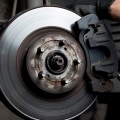When it comes to the powertrain of your Triumph TR, you need to understand the transmission specs and types. Whether you're looking for efficient performance, fast shifting, or smooth operation, it's important to know the details of the transmission and its components. In this article, we'll take a deep dive into transmission specs and types so you can make the best decision for your vehicle. Transmission specs and types are an essential component of the Triumph TR's powertrain. The type of transmission specs affects performance, fuel efficiency, and driving dynamics.
This article will explore the various types of transmission specs available for the Triumph TR, as well as how they affect performance.
Manual Transmission
: The most common type of transmission spec for the Triumph TR is manual transmission. Manual transmissions use gears that are shifted manually by a driver with the use of a clutch. This allows drivers to select the gear they require in order to match their driving style.Manual transmission provides more control over the vehicle, as drivers can shift gears to suit their needs. However, manual transmissions are less fuel efficient than automatic transmissions and require more frequent maintenance. The Triumph TR offers manual transmissions in both 6-speed and 8-speed variants.
Automatic Transmission
: Automatic transmissions are becoming increasingly popular due to their convenience and reliability.Automatic transmissions use gears that are shifted automatically, without any input from the driver. This allows the vehicle to shift gears according to driving conditions, such as speed and engine load. Automatics are generally more fuel efficient than manuals, as they can shift to higher gears quickly and efficiently. The Triumph TR offers automatic transmissions in both 6-speed and 8-speed variants.
Dual-Clutch Transmission: Dual-clutch transmissions (DCTs) are a type of automated manual transmission that uses two clutches to shift gears. DCTs offer faster gear shifts than traditional automatic transmissions, as they can shift gears without interrupting power delivery to the wheels. DCTs also provide improved acceleration and improved fuel efficiency compared to traditional automatics. The Triumph TR offers dual-clutch transmissions in both 6-speed and 8-speed variants.
Continuously Variable Transmission (CVT): CVTs are a type of automatic transmission that uses an infinite range of gear ratios. This allows CVTs to provide seamless shifts and improved fuel efficiency. CVTs also have better performance in low-speed driving situations than traditional automatics. The Triumph TR offers continuously variable transmissions in both 6-speed and 8-speed variants. The type of transmission spec you choose will affect the performance, fuel efficiency, and driving dynamics of your Triumph TR.
Manual transmissions provide more control over the vehicle and can be more fuel efficient if driven correctly, but require more frequent maintenance. Automatic transmissions offer convenience and improved fuel efficiency, but lack the control offered by manual transmissions. Dual-clutch transmissions provide faster gear shifts and improved acceleration compared to traditional automatics, but come with added complexity and cost. Finally, continuously variable transmissions offer seamless shifting and improved fuel efficiency compared to traditional automatics, but have limited low-speed performance. In addition to the type of transmission spec, there are also various features and technologies available with specific transmission specs that can affect performance, fuel efficiency, and driving dynamics.
For example, some models may offer launch control or hill-start assist for improved acceleration, or adaptive cruise control for increased fuel efficiency while cruising on highways. It is important to consider these features when selecting a transmission spec for your Triumph TR. In addition to choosing the right type of transmission spec for your Triumph TR, proper maintenance is also essential for optimal performance. Regular oil changes are important for all types of transmission specs to keep them running smoothly and reduce wear and tear on internal components. It is also important to check fluid levels regularly and replace any worn components such as filters or gaskets.
With proper maintenance, you can ensure that your transmission specs remain in top condition for optimal performance.
Additional Technologies
The Triumph TR offers a variety of additional technologies that can be used with certain transmission specs. These technologies can help maximize the performance of the vehicle and make driving easier. Launch control is one such technology, and it helps the driver to launch the car from a stop with maximum power. Hill-start assist is another technology that helps to prevent the car from rolling back when starting on an incline.Both of these features are available with some transmission specs for the Triumph TR.
Maintenance Requirements
Transmission specs and types are essential components of the Triumph TR's powertrain, and it is important that they are kept in optimal working condition in order to ensure the safety and performance of the vehicle. Maintenance requirements vary between different transmission specs, so it is important to be aware of the specific needs of the transmission you are using.Automatic Transmissions:
Automatic transmissions require regular maintenance, including checking and changing the oil, inspecting the gaskets, seals, and hoses, and ensuring that all parts are in good condition. Additionally, it is important to check the transmission fluid levels, as low levels can cause problems such as slipping or jerking.It is also important to inspect the fluid for signs of contamination or break-down.
Manual Transmissions:
Manual transmissions require regular checks on the clutch, gearbox, and other components such as the driveshaft. It is important to check for any signs of wear or damage and replace any worn parts. Additionally, manual transmission fluid should be changed regularly to ensure optimal performance.Tips for Optimal Performance: To ensure that your transmission specs are performing optimally, it is important to ensure that all parts are kept clean and well lubricated. Additionally, it is important to inspect all moving parts for signs of wear or damage and replace any worn parts. Finally, it is important to follow the manufacturer’s instructions for regular maintenance and servicing.
Impact on Performance
Transmission specs are essential components of the Triumph TR's powertrain, and they can have a significant impact on performance, fuel efficiency, and driving dynamics.Different types of transmission specs include manual transmissions, automatic transmissions, and continuously variable transmissions (CVTs).Manual transmissions offer drivers greater control over shifting, but they can be more difficult to operate than automatic or CVT transmissions. They typically require more effort to shift, resulting in slightly lower fuel economy and increased wear-and-tear on the vehicle. Manual transmissions also tend to be less efficient than automatic or CVT transmissions, resulting in lower overall performance. Automatic transmissions offer drivers convenience and ease of use, but they can be less efficient than manual transmissions and may not always provide the best acceleration or top speed. Automatic transmissions also use more fuel than manual transmissions, so they can have an adverse effect on fuel efficiency. CVT transmissions are becoming increasingly popular in modern vehicles due to their efficiency.
They are designed to maintain a consistent engine speed, allowing for smoother acceleration and increased fuel efficiency. However, CVTs can be more expensive than manual or automatic transmissions, and they may require specialized maintenance. The type of transmission specs used in the Triumph TR can have a significant impact on performance, fuel efficiency, and driving dynamics. Drivers should carefully consider their needs and preferences before choosing the type of transmission that best suits their needs.
Different Types of Transmission Specs
Transmission specs play a vital role in the performance of the Triumph TR. There are a variety of transmission specs available, each with its own advantages and disadvantages.Manual Transmission: Manual transmission is the most common type of transmission found in the Triumph TR, and is often used for racing and performance-oriented vehicles. It provides greater control over the vehicle, with the driver being able to select the gear ratio and shift points. Manual transmission also offers better fuel economy compared to automatic transmission, and can be tuned for specific performance needs.
Automatic Transmission
: Automatic transmission is another popular transmission type for the Triumph TR. It offers convenience and smooth shifting, making it ideal for daily drivers and recreational vehicles.Automatic transmission can also be tuned for performance purposes, however it does not offer the same level of control as manual transmission.
Dual Clutch Transmission (DCT)
: The Dual Clutch Transmission (DCT) is a relatively new type of transmission which combines aspects of both manual and automatic transmissions. It offers fast, smooth shifts, as well as improved fuel economy. DCTs can also be tuned for performance purposes, but do not offer as much control as manual transmissions.Continuously Variable Transmission (CVT)
: The Continuously Variable Transmission (CVT) is an automatic transmission which is designed to provide optimal performance and fuel economy. It uses a belt-and-pulley system to provide infinite gear ratios, allowing it to always be in the optimal gear for acceleration or fuel economy.CVTs are ideal for daily drivers and recreational vehicles. When selecting a transmission spec for your Triumph TR, it is important to consider your driving style and needs. Manual transmission is best for those who are looking for maximum control over their vehicle, while automatic transmissions are better suited for daily drivers. Dual clutch transmissions offer fast shifting and improved fuel economy, while continuously variable transmissions are best for those looking for optimal performance and fuel economy. The different types of transmission specs available for the Triumph TR are essential components of its powertrain and affect performance in a variety of ways. Automatic transmissions are generally more convenient and efficient, while manual transmissions are often more customizable and provide greater control.
Additionally, some transmissions may include additional technologies such as torque converters or continuously variable transmissions. Proper maintenance of the transmission is also important for reliable and long-term performance. This article has explored the various types of transmission specs available for the Triumph TR, as well as how they affect performance. For more information on transmission specs and types, readers can explore additional resources and other related articles.


